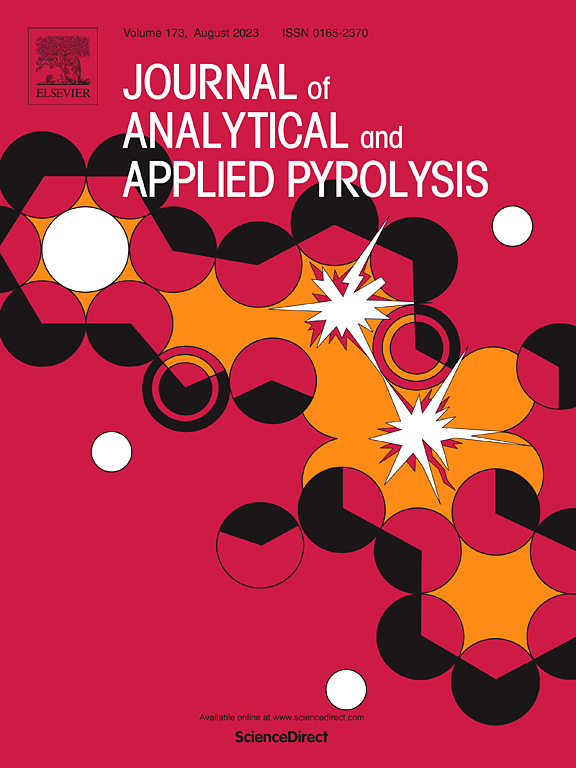Comparative study of the pyrolysis of sawdust contaminated with hydraulic oil and metals from industrial activities and raw sawdust for the production of biochar and bio-oil
IF 6.2
2区 化学
Q1 CHEMISTRY, ANALYTICAL
引用次数: 0
Abstract
Inappropriate disposal of contaminated sawdust by industry poses significant environmental and energy challenges. This study investigates the pyrolysis of raw sawdust (RWS) and sawdust contaminated with hydraulic oils and brass slag (SCH) in a discontinuous pyrolysis reactor system. SCH, composed of 49 % RWS, 44 % hydraulic fluid and 7 % brass slag, has a higher carbon content (18.71 %) and calorific value (28.67 MJ/kg) than RWS (13.05 % and 18.27 MJ/kg), but less volatile matter (70.33 % vs. 80.12 %).Thermogravimetric analysis (TGA/DTG) indicates that hydraulic oil contamination accelerates the decomposition of SCH, lowering its onset temperature and increasing its residual mass due to incomplete volatilization and metallic additives. Pyrolysis at 450–600°C produced less biochar from SCH (16.66 %), but higher yields of bio-oil (up to 59 %) and gas (71.66 %). Oxygenated compounds were the dominant compounds in the bio-oil composition, which included phenols, nitrogen-containing compounds, guaiacols, organic acids, ketones, sugars, hydrocarbons, esters, furans and alcohols.Biochar characterization revealed structural and chemical differences between SCH-derived and RWS-derived biochar.FTIR spectroscopy revealed similar functional groups in both biochars, but the SCH biochar exhibited faster volatilization of aliphatic components and higher reactivity. SEM-EDX analysis revealed a heterogeneous morphology containing embedded metal particles. SCH biochar showed increased porosity and a calorific value of 30.07–30.64 MJ/kg, comparable to that of low-grade coal. These results demonstrate the energy potential of contaminated sawdust in a discontinuous pyrolysis reactor system, but further assessment of its environmental impacts is required to ensure sustainable application.
工业活动中液压油和金属污染的木屑与原木屑热解制备生物炭和生物油的对比研究
工业对受污染木屑的不当处理构成了重大的环境和能源挑战。研究了在不连续热解反应器系统中对原木屑(RWS)和受液压油和黄铜渣污染的木屑(SCH)的热解过程。由49 % RWS、44 %液压油和7 %黄铜渣组成的SCH碳含量(18.71 %)和热值(28.67 MJ/kg)高于RWS(13.05 %和18.27 MJ/kg),但挥发分(70.33 %比80.12 %)较少。热重分析(TGA/DTG)表明,液压油污染加速了SCH的分解,由于挥发不完全和金属添加剂的存在,降低了SCH的起始温度,增加了SCH的残余质量。在450-600°C热解时,SCH产生的生物炭较少(16.66 %),但生物油(高达59 %)和气体(71.66 %)的产量较高。含氧化合物是生物油的主要成分,包括酚类、含氮化合物、愈创木酚、有机酸、酮类、糖类、烃类、酯类、呋喃类和醇类。生物炭的表征揭示了sch衍生生物炭和rws衍生生物炭在结构和化学上的差异。FTIR光谱显示两种生物炭的官能团相似,但SCH生物炭的脂肪族成分挥发更快,反应活性更高。SEM-EDX分析显示含有嵌入金属颗粒的异质形貌。SCH生物炭孔隙度增大,热值为30.07 ~ 30.64 MJ/kg,与低品位煤相当。这些结果证明了污染木屑在不连续热解反应器系统中的能源潜力,但需要进一步评估其环境影响以确保其可持续应用。
本文章由计算机程序翻译,如有差异,请以英文原文为准。
求助全文
约1分钟内获得全文
求助全文
来源期刊
CiteScore
9.10
自引率
11.70%
发文量
340
审稿时长
44 days
期刊介绍:
The Journal of Analytical and Applied Pyrolysis (JAAP) is devoted to the publication of papers dealing with innovative applications of pyrolysis processes, the characterization of products related to pyrolysis reactions, and investigations of reaction mechanism. To be considered by JAAP, a manuscript should present significant progress in these topics. The novelty must be satisfactorily argued in the cover letter. A manuscript with a cover letter to the editor not addressing the novelty is likely to be rejected without review.

 求助内容:
求助内容: 应助结果提醒方式:
应助结果提醒方式:


